

The Republic of Austria, a parliamentary democracy located in mountainous central Europe, has an area of 32,374 sq. mi. (83,850 sq. km.) and a population of 8.08 million. Capital: Wien (Vienna). Austria is primarily an industrial country. Machinery, iron, steel, textiles, yarns and timber are exported.
The territories later to be known as Austria were overrun in pre-Roman times by various tribes, including the Celts. Upon the fall of the Roman Empire, the country became a margravate of Charlemagne’s Empire. Premysl II of Otakar, King of Bohemia, gained possession in 1252, only to lose the territory to Rudolf of Habsburg in 1276. Thereafter, until World War I, the story of Austria was conducted by the ruling Habsburgs.
During the 17th century, Austrian coinage reflected the geo-political strife of three wars. From 1618-1648, the Thirty Years’ War between northern Protestants and southern Catholics produced low quality, “kipperwhipper” strikes of 12, 24, 30, 60, 75 and 150 Kreuzer. Later, during the Austrian-Turkish War, 1660-1664, coinages used to maintain soldier’s salaries also reported the steady division of Hungarian territories. Finally, between 1683 and 1699, during the second Austrian-Turkish conflict, new issues of 3, 6 and 15 Kreuzers were struck, being necessary to help defray mounting expenses of the war effort.
During World War I, the Austro-Hungarian Empire was one of the Central Powers with Germany, Bulgaria and Turkey. At the end of the war, the Empire was dismembered and Austria established as an independent republic. In March 1938, Austria was incorporated into Hitler’s short-lived Greater German Reich. Allied forces of both East and West occupied Austria in April 1945, and subsequently divided it into 4 zones of military occupation. On May 15, 1955, the 4 powers formally recognized Austria as a sovereign independent democratic state.
Model 1870
This revolver is built on a Lefaucheux-Francotte double action solid frame with fixed cylinder with mechanical rod ejection. It is chambered for the 11.3mm cartridge and fitted with a 7.3-inch round barrel. The non-fluted cylinder holds 6 rounds. The frame and barrel were iron, not steel. Checkered wooden grips with lanyard loop. Built by the Austrian firm of Leopold Gasser, and marked “L.GASSER, WIEN, PATENT, OTTAKRING.” Weight is about 53 oz., or 3.3 lbs., making it one of the heaviest military service revolvers of its time. When the Model 1878 was introduced and adopted by the Austro-Hungarian army, the Model 1870 was sold to the Balkan States and was sometimes referred to as the “Montenegrin” revolver.
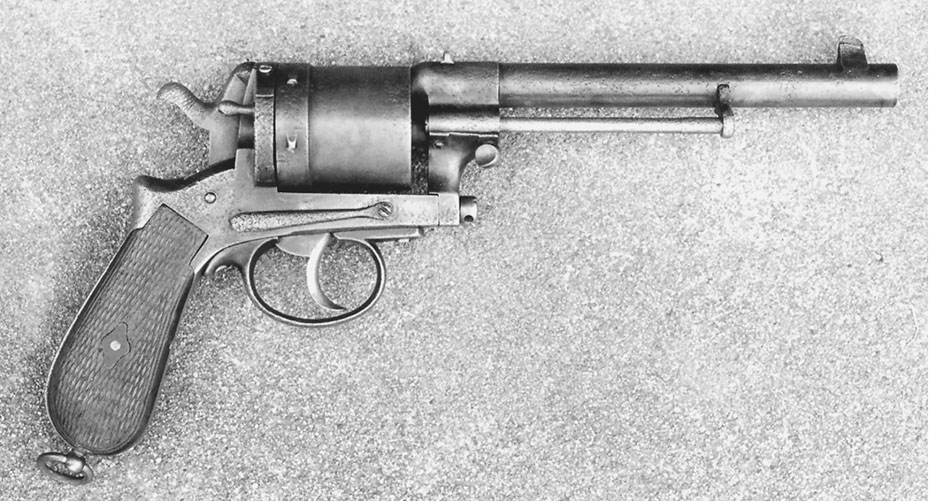

Model 1870 • Courtesy J. B. Wood
Military Unit Marked
Exc. |
V.G. |
Good |
Fair |
1250 |
750 |
400 |
250 |
Non-Unit Marked
Exc. |
V.G. |
Good |
Fair |
900 |
600 |
350 |
225 |
Model 1870/74 Gasser Trooper’s Model
Similar to the above model but built with cast steel instead of iron. It was issued from 1874 to 1919. Built by the Austrian firm of Leopold Gasser. Weight is still about 53 oz.
Military Unit Marked
Exc. |
V.G. |
Good |
Fair |
1250 |
750 |
400 |
200 |
Non-Unit Marked
Exc. |
V.G. |
Good |
Fair |
900 |
600 |
350 |
200 |
Model 1878 Officer’s Model
Because the Model 1870 revolver was so heavy and large, Johann Gasser, Leopold’s younger brother, designed a smaller version chambered for the 9mm (9×26) cartridge. The barrel length was 4.8 inches and the overall length was reduced as well. The weight of this revolver was about 27 oz.
Exc. |
V.G. |
Good |
Fair |
850 |
600 |
350 |
200 |
Model 1898 Rast & Gasser
This model was built on the Schmidt-Galand double action solid frame with 8-round cylinder with loading gate and mechanical ejection rod. Chambered for the 8mm cartridge and fitted with a 4.5-inch round barrel. The caliber was too light to be effective as a military sidearm. The firing pin was a spring-loaded frame-mounted plunger instead of the more common hammer-mounted type. Checkered wooden grips with lanyard loop. In service from 1898 to 1938. Weight is about 33 oz.
Short Grip
Exc. |
V.G. |
Good |
Fair |
600 |
450 |
300 |
200 |
Short Barrel
Exc. |
V.G. |
Good |
Fair |
3000 |
2200 |
1500 |
900 |

Model 1898 • Paul Goodwin photo
Osterreichische Waffenfabrik Gesellschaft GmbH,
Steyr (1869-1919)
Steyr-Werke AG (1919-1934)
Steyr-Daimler-Puch, Steyr (1934-1990)
Steyr-Mannlicher GmbH, Steyr (1990-)
Steyr Model 1893 Gas Seal Test Revolver
Chambered for the 8mm cartridge this 7-shot 5.5-inch barrel revolver was built by Steyr as a prototype for the Austrian army. Fewer than 100 were built. Several different variations. It is recommended that an expert be consulted prior to a sale.
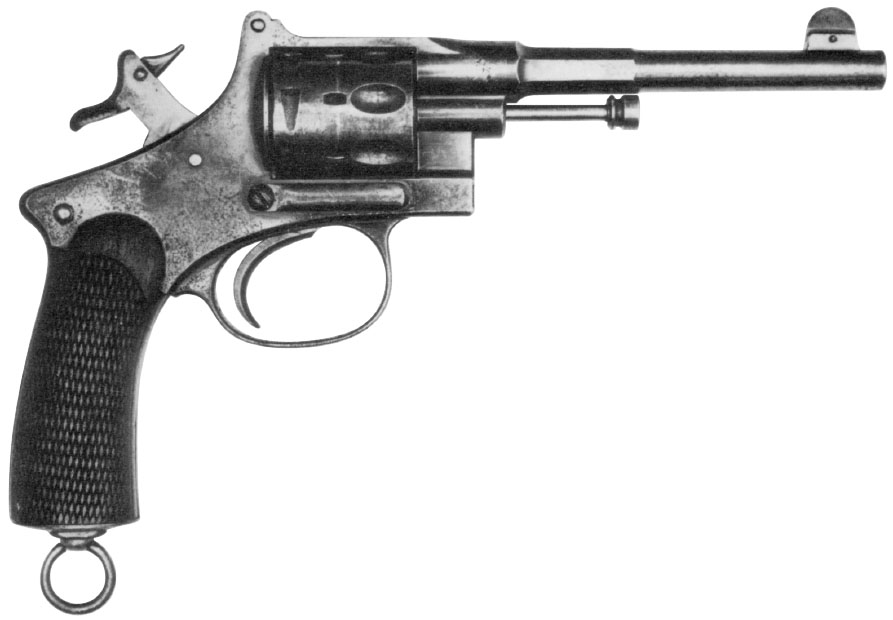
Courtesy Geschichte und Technik der europaischen Militarrevolver, Journal-Verlag Schwend GmbH with permission
Exc. |
V.G. |
Good |
Fair |
15000 |
10000 |
7500 |
4000 |
Roth Steyr Model 1907
Based on the patents granted to Karel Krnka and Georg Roth, the 8mm Model 1907 had a rotating barrel locking system and was the first self-loading pistol adopted by the Austro-Hungarian army. It was also the first successful double action automatic pistol. Add 20 percent for early Steyr examples without a large pin visible on right side of frame, or for those made in Budapest instead of Steyr.

Courtesy Joseph Schroeder
Exc. |
V.G. |
Good |
Fair |
1100 |
750 |
550 |
350 |
Holster for Steyr Model 1907
Leather construction. Top flap. Separate pouch for clips on the Left side. Single belt loop on back. A scarce holster.
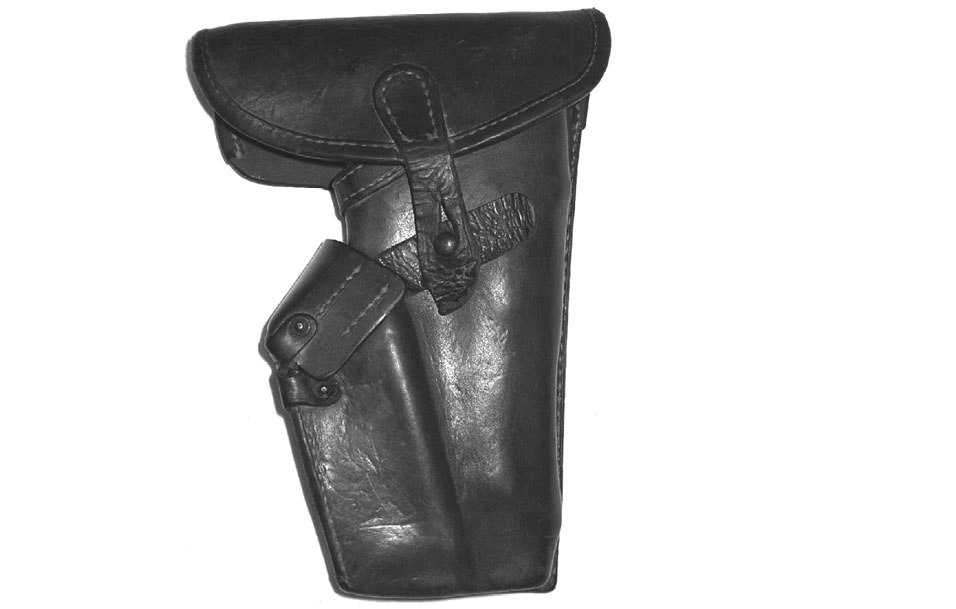
Steyr Model 1907 holster
Exc. |
V.G. |
Good |
Fair |
500 |
350 |
200 |
125 |
Steyr Hahn Model 1911
The Steyr Hahn was originally introduced as a commercial pistol but was quickly adopted by the Austro-Hungarian, Chilean, and Romanian militaries. Magazine capacity is 8 rounds. Weight is about 30 oz. Commercial examples were marked “Osterreichische Waffenfabrik Steyr M1911 9m/m” on the slide, have a laterally adjustable rear sight, and are rare. Austrian militaries are marked simply “STEYR” and the date of manufacture, while those made for Chile and Romania bear their respective crests. Some of the Romanian or Chilean contract pistols have been imported to the U.S. recently. These were refinished and had the crests ground off.
During WWII the Germans rebarreled a number of Steyr Hahns to 9mm Parabellum for police use, adding “P.08” to the slide along with appropriate Waffenamt markings. The German army designation for this pistol was “Pistole Mod 12(o).”

Steyr Hahn Model 1911 with Chilean crest • Courtesy Orvel Reichert
Commercially Marked
Exc. |
V.G. |
Good |
Fair |
1250 |
900 |
700 |
350 |
P.08 Marked Slides, see entry under Germany
Austrian Military
Exc. |
V.G. |
Good |
Fair |
650 |
500 |
400 |
250 |
Romanian or Chilean contract, original finish with intact crest
Exc. |
V.G. |
Good |
Fair |
700 |
500 |
400 |
250 |
Romanian or Chilean contract, refinished with ground crest
Exc. |
V.G. |
Good |
Fair |
N/A |
N/A |
250 |
175 |

Close-up of slide showing conversion number “08” for 9×19 caliber • Courtesy Orvel Reichert
Model 1908/34
A pistol designed by Nicolas Pieper and made under license by Osterreichische Waffenfabrik. It is chambered for 7.65mm and has a 3.6” barrel. One notable feature of this design is the tip up barrel which is released by the lever on the left side. Purchased by Austro-Hungarian military and police through WW1. Made 1908 – 1928. The slide on the original Steyr-Pieper model 1908 was re-designed due to some problems that were experienced from heavy use by the Austrian police. A new heavy duty slide was added to the model 1908 along with a few other changes and giving the pistol a new designation of 1908/34. This stronger slide was devoid of all markings which were moved to the upper frame underneath the slide. A spring recoil buffer was added to the rear of the pistol. A non-adjustable rear sight which replaced a drift adjustable version was milled into the top of the new slide.
Exc. |
V.G. |
Good |
Fair |
700 |
450 |
275 |
200 |
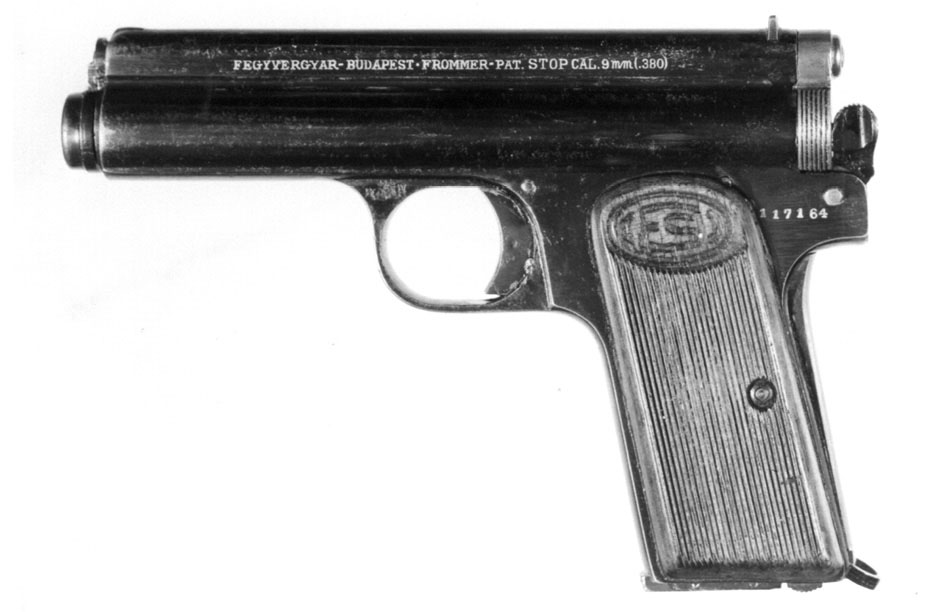
Courtesy James Rankin
FEG (Frommer) Stop Model 1912
Introduced in 1912 and took a whole new approach compared to any of the pistols this company had produced to that point. It is still unconventional as it uses two recoil springs in a tube above the barrel and resembles an air pistol in this way. It is chambered for 7.65mm or 9mm short and has a 3.75-inch barrel. The detachable magazine holds 7 rounds, and the sights are fixed. This locked-breech action, semi-automatic pistol was a commercial success. It was used widely by the Austro-Hungarian military during WWI. It was manufactured between 1912 and 1920.
Exc. |
V.G. |
Good |
Fair |
575 |
400 |
250 |
150 |
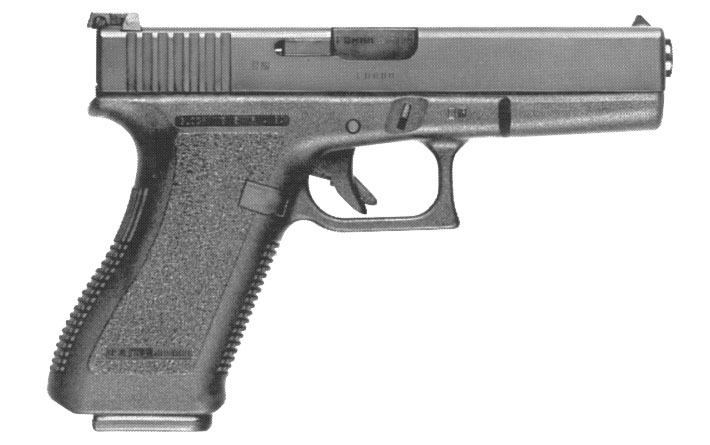
Glock 17
Adopted by the Austrian military in 1983. This model is chambered for the 9mm Parabellum cartridge. It is a double action only semi-automatic that has a 4.49-inch barrel and a 17-shot detachable magazine. The empty weight of this pistol is 21.91 oz. It is not believed that any Austrian-issue Glocks have been imported to the U.S. This pistol was introduced on the U.S. civilian market in 1985 and is still currently produced. See Standard Catalog of Firearms for commercial prices.
Steyr-Solothurn MP 30
Introduced in 1930 and built at the Steyr plant under license from the Swiss firm, Solothurn. It was adopted by the Austrian police. Chambered for the 9×23 Steyr cartridge and fitted with a 7.8-inch jacketed barrel. It is fed by a 32-round magazine and has a rate of fire of about 500 rounds per minute. Wood buttstock with unusual upswept appearance. It is select fire. Weight is about 9.5 lbs. Produced from 1930 to 1935 with approximately 6,000 manufactured.
Pre-1968

Steyr Model 1930 • Courtesy Thomas Nelson, from World’s Submachine Guns, Vol. I
Exc. |
V.G. |
Fair |
17500 |
12500 |
10000 |
Pre-1986 reweld
Exc. |
V.G. |
Fair |
8500 |
7500 |
N/A |
Steyr-Solothurn S1-100 [MP 34(o)]
This gun machine was designed in Germany, perfected in Switzerland, and built in Austria. Steyr-Solothurn was a shell company established to enable the German company Rheinmetall to evade the restrictions of the Versailles Treaty that prevented them from producing military small arms. The gun was used by the Austrian army as well as the German army. It is chambered for the 9×23 Steyr cartridge as well as others. The German army used them in 9mm Parabellum while Austrian troops used the gun chambered for the 9mm Mauser cartridge. The gun was also sold to Portugal where it was designated the Model 42. Barrel length is almost 7.8 inches. Magazine capacity is 32 rounds. Rate of fire is about 500 rounds per minute. Fixed wooden butt and forearm. Weight is approximately 9.5 lbs. Produced from 1934 to 1939. On this gun, a magazine loading device is built into the magazine housing.

MP 34 • Paul Goodwin photo
Pre-1968
Exc. |
V.G. |
Fair |
17500 |
12500 |
10000 |
Pre-1986 reweld
Exc. |
V.G. |
Fair |
8500 |
7500 |
N/A |
Steyr MPi69
Built in Austria, this submachine gun is chambered for the 9mm cartridge. It was adopted by the Austrian army in 1969. The gun features a 10-inch barrel and 25- or 32-round magazine. It has a rate of fire of 550 rounds per minute. It is marked “STEYR-DAIMLER-PUCH AG MADE IN AUSTRIA” on top of the receiver. The folding stock is metal. The gun weighs about 7 lbs. Production stopped in 1990.
Pre-1968 (Rare)

Courtesy private NFA collection
Exc. |
V.G. |
Fair |
15000 |
12000 |
N/A |
Austrian Pre-Cartridge Era Rifles
The end of the Napoleonic Wars found the army of the Austria Hungarian Empire armed with a variety of flintlock firearms. The foot troops carried either the M1798 or the M1807 musket or the M1807 yager rifle. The mounted forces were armed with either the M1798 dragoon carbine, the M1798 Hussarcarbine, the M1798 rifled cavalry carbine, the M1781 Cuirassier musketoon, and the M1798 pistol. In 1828 a new flintlock musket superseded the M1798 pattern, only to be modified again in 1835. In the latter years, however, the Austrian military also began experimenting with a variation of the percussion system invented by Giuseppe Console, utilizing a small elongated copper cylinder filled with fulminate. In 1840, the flintlock muskets adopted in 1835 were adapted to a variation of this percussion system as modified by Baron von Augustin. This system was made army-wide in 1842 with the adoption of a new musket and yager rifle with locks specifically manufactured for the Augustin tubelocks. In 1849, a new rifle replaced the M1842 pattern; both of these rifles were based on the Devilgne chambered breech. In 1850, a cavalry carbine and a horse pistol were added to the tubelock series. All of these arms were either .69 or .71 caliber. The tubelock, however, was short-lived; in 1854, Austria abandoned the tubelock system in favor of standard percussion cap then widely used by the armies of Europe. At the same time it adopted a new smaller caliber (.54) which it applied to the new M1854 rifle-musket and the M1855 yager rifle. A horse pistol based on the same system (Lorenz’s compressed, elongated ball) was adopted in 1859.
Large numbers of the Austrian longarms were imported to the United States in the first two years of the American Civil War. Beginning in 1863, the Confederate States also imported large numbers of the M1854 series rifle-muskets. Most of the tubelocks first being modified to standard percussion in Belgium before importation, arms of prime interest to American collectors, accordingly demand higher prices.
In 1867, the Austria-Hungarian Empire adopted two different breechloading mechanisms and the self-contained metallic cartridge. Those muzzleloading arms deemed acceptable for alteration (the M1854 series of rifle-muskets and rifles) were adapted to the Wanzel system. Newly made arms (the M1867 rifle) were made in conformity with Werndl’s breechloading design.
Austrian arms were generally made on contract with the major gun makers in and near Vienna (“Wien” in Austrian). These makers usually marked their products with their name upon the barrel of the arm, near the breech. The major makers included BENTZ, FERD. FRUWIRTH (who also simply marked his arms “F. F.”), CARL HEISER, JOSEF JESCHER, ANNA OSTERLIEN, PIRKO, TH. ROTTME, G. SCHLAGER, TH. SEDERE, F. UMFAURER, WANZEL, and ZEILINGER (with the “Z” usually backwards). Lockplates were marked with the government ownership mark (a small double-headed eagle) and the date of manufacture (deleting the number “1” from the year, such as “847” for “1847”.) Since the arms were not interchangeable, mating numbers are usually found on all the metal parts.
Austrian Musket, M1828
Overall length 57-3/4 inches; barrel length 42-1/2 inches; caliber .69. Basically following the pattern of the French M1822 musket, this arm still accepted the quadrangular M1799 bayonet, distinguished by having a solid socket with a hook ring at its rear, like the Prussian bayonet for the M1808 musket.
Exc. |
V.G. |
Good |
Fair |
Poor |
— |
2000 |
1650 |
950 |
400 |
Austrian Musket, M1835
Overall length 57-3/4 inches; barrel length 42-1/2 inches; caliber .69. The M1835 musket follows the pattern of the Austrian M1807 musket, but is adapted for the Consule tubelock percussion system, which essentially replaced the frizzen and pan with a hinged tube retainer. This arm still uses the M1799 quadrangular bayonet.
Exc. |
V.G. |
Good |
Fair |
Poor |
— |
2500 |
2000 |
1200 |
450 |
Austrian Musket, M1840
Overall length 57-3/4 inches; barrel length 42-1/2 inches; caliber .69. The M1840 musket was manufactured in flint. Its primary differences from the M1828 musket lie in its furniture (mainly the front band) and the bayonet attachment, which consists of a lug beneath the barrel and an elongated hook projecting from the forend of the stock to accept the new M1840 quadrangular bayonet. The bayonet is distinguished by having a straight slot in its socket, closed by a bridge.
Exc. |
V.G. |
Good |
Fair |
Poor |
— |
2500 |
1800 |
1100 |
450 |
Austrian Musket, M1842
Overall length 57-3/4 inches; barrel length 42-1/2 inches; caliber .69 (.71). The M1842 musket was manufactured in Augustin tubelock. Its main distinction from the M1840 flintlock musket is the lock, which in addition to having the integral hinged tubelock mechanism in lieu of the frizzen, has a distinctly rounded rear tail. Although 25,000 of these muskets were imported into the United States for use by Fremont’s forces in Missouri in 1861, many were subsequently altered to percussion. The Cincinnati contractors, Hall, Carroll & Co. or Greenwood & Co. accounted for 10,000 of these arms, all of which were altered to percussion by means of the cone-in-barrel system. These were also rifled and a portion of them sighted with a long range rear sight similar to the Enfield P1853 rifle-musket. Many of the balance were subsequently sent to the Frankfort Arsenal in Philadelphia, where they were subcontracted to Henry Leman of Lancaster for alteration to standard percussion. Those altered by Leman are distinguished by having a new breechpiece with integral bolster, the latter with a cleanout screw through its face. In addition to the 25,000 imported for Fremont, the firm of H. Boker & Co. of New York imported approximately 8,000 Austrian M1842 muskets which it had altered to percussion in Belgium. The French method of adding a reinforced bolster to the top right-hand side of the barrel was used. Many of those were also rifled and sighted in the manner of the French adaptations fashionable in Europe. George Heydecker of New York City imported another 4,000 in 1863 that were seized in transit to Canada, reputedly for delivery to Mexican republican forces.

In original tubelock
Exc. |
V.G. |
Good |
Fair |
Poor |
— |
3500 |
2500 |
1500 |
600 |
Altered to percussion (Cincinnati contractors)
Exc. |
V.G. |
Good |
Fair |
Poor |
— |
2000 |
1500 |
800 |
300 |
Altered to percussion (Leman)

Exc. |
V.G. |
Good |
Fair |
Poor |
— |
2000 |
1500 |
800 |
350 |
Altered to percussion and rifled (Boker)
Exc. |
V.G. |
Good |
Fair |
Poor |
— |
2000 |
1500 |
800 |
350 |
Austrian M1844 “Extra Corps” Musketoon
Overall length 48-3/8 inches; barrel length 33-1/2 inches; caliber .69 (.71). Is essentially a shortened version of the Austrian M1842 musket. In original Augustin tubelock, it is virtually unknown. Most of the production is thought to have been purchased by arms speculators at the beginning of the American Civil War and altered to standard percussion in Liege, Belgium. The Belgian alteration followed the second pattern adopted by that government to alter arms to percussion and consisted of brazing a “lump” of metal to the upper right-hand side of the barrel, into which a cone was threaded. The arms so altered were also rifled and sighted. The sights either copied the Austrian M1854 rifle-musket folding sight or the French “ladder” rear sight using the pattern utilized on the M1829 rifled cavalry musketoon. Over 10,000 of these arms were imported into the United States in 1861-1862 by Herman Boker & Co. of New York City.
Altered to percussion and rifled (Boker)
Exc. |
V.G. |
Good |
Fair |
Poor |
— |
2250 |
1750 |
950 |
400 |
Austrian M1842 Yager rifle
Overall length 48-1/4 inches; barrel length 33-1/4 inches; caliber .69/.71. The Austrian M1842 yager rifle (“Kammer Busche”) was originally manufactured in tubelock for the rifle battalions of the Austrian Army. Its bore terminated in a Delvigne breech, i.e. a chamber of lesser diameter than the caliber whose lip served as a base for disfiguring the projectile to fill the rifling. Made obsolete by the Thouvenin and Minie systems, many M1842 yager rifles were altered in 1860 in Belgium to standard percussion and sold to the Italian revolutionaries led by Giuseppe Garibaldi, giving the gun that nickname. Two methods of alteration were applied. One, the “Belgian” system, brazed a “lump” of iron to the upper right surface of the breech, which was tapped for a standard percussion cone. The other, the “Prussian,” involved fitting the breech with a new barrel section incorporating a new bolster. At least 500 of these altered arms were imported into the United States during the American Civil War, where they (and the M1849 yager rifles similarly altered) were called “Garibaldi Rifles.”
Exc. |
V.G. |
Good |
Fair |
Poor |
— |
2500 |
1750 |
1000 |
350 |
Austrian M1849 Yager rifle
Overall length 48 inches; barrel length 33-1/4 inches; caliber .71. The successor to the M1842 Austrian “Kammer Busche,” the M1849 model is distinguished by having its barrel wedge fastened rather than retained by bands. Both the M1842 and the M1849 yager rifles were adapted to socket bayonets having long straight knife blades; both socket types were slotted. That of the M1842 was secured to the barrel by the same method as the M1842 Austrian musket; that of the M1849, however, locked onto a lug on the right side of the barrel and was secured by a rotating ring on the back of the socket. Adapted to standard percussion in the same manner as the M1842 yager rifles, more than 25,000 were sold to the U.S. War Department in 1862 and 1863.

Exc. |
V.G. |
Good |
Fair |
Poor |
— |
2500 |
1750 |
1000 |
350 |
Austrian M1850 Horse Pistol
Overall length 16 inches; barrel length 8-7/8 inches; caliber .69. A bulky brass mounted pistol with lanyard ring, this arm was made originally in tubelock. However, a small quantity appear to have been altered to standard percussion locks in Liege, Belgium. In the process the double-strapped front bands of the original were removed and the forestock cut away to adapt the stock to an iron ramrod. (In Austrian service the ramrod was hung from the crossbelt of the mounted trooper.) Quantities imported into the United States are uncertain but may have been included among the 346 foreign horse pistols purchased by the U.S. War Department from P.S. Justice in 1861.
Exc. |
V.G. |
Good |
Fair |
Poor |
— |
2650 |
1800 |
800 |
400 |
Austrian M1850 Carbine
Overall length 30 inches; barrel length 14-1/2 inches; caliber .71. Originally manufactured in tubelock for Austrian cavalry service, this large caliber, short-barreled rifled carbine (12-groove rifling) saw service in the United States when 10,000 were purchased by U.S. purchasing agent George Schuyler in 1861. Those purchased for U.S. service, however, had been altered in Liege, Belgium for standard percussion locks in the same manner that the Austrian M1842 and M1849 yager rifles had been altered.

Exc. |
V.G. |
Good |
Fair |
Poor |
— |
2250 |
1650 |
1000 |
450 |
M1854 Rifle-Musket (The “Lorenz”)
Overall length 52 inches; barrel length 37-1/4 inches; caliber .54 (and .58). Adopted in 1854 as a replacement for its smoothbore muskets, the Austrian M1854 rifle-musket was made in three variants. The standard infantry arm had a simple block sight for mass volley fire. The rifles for the “rear rank” men were similar but with a folding leaf sight with windows graduated to 900 paces. A similar sight was also applied to the rifles for sharpshooter battalions, which also had a cheekpiece built into the buttstock. The quadrangular socket bayonet locked onto the front sight, whose sides were angled to accept the diagonal slot in the bayonet’s socket. The Austrian M1854 rifle-musket was the second most prolifically imported arm during the American Civil War, with some 89,000 being imported into the Confederacy and more than 175,000 into the Union. Thousands of the latter were bored up to .58 caliber before being imported.

Exc. |
V.G. |
Good |
Fair |
Poor |
— |
1650 |
1200 |
800 |
350 |
M1854 Yager Rifle
Overall length 43 inches; barrel length 28 inches; caliber .54. Designed for the rifle battalions of the Austrian army to replace the M1842 and M1849 rifles, the M1854 yager rifles are distinguished by having an octagonal, wedge-fastened barrel turned round near the muzzle to accept a socket bayonet with a long straight knife blade. An angled lug on the turned section engaged the diagonal slot in the bayonet’s socket. The rear sight for these rifles is unusual, consisting of a curved slide that traverses two upright walls and can be locked with a turn key on its right side for various ranges up to 900 paces. These rifles were made for Austrian service without provision for a ramrod (that device being affixed to a crossbelt of the individual soldier). But the approximately 2,500 that were imported for U.S. service during the American Civil War were adapted for a ramrod by inletting a channel under the forestock.
Exc. |
V.G. |
Good |
Fair |
Poor |
— |
2500 |
1850 |
1200 |
500 |
Austrian M1859 Horse Pistol
Overall length 16 inches (less stock); barrel length 10-3/8 inches; caliber .54. The M1850 tubelock pistol was replaced in the Austrian service in 1859 with a new standard percussion rifled horse pistol firing the Lorenz “compression” elongated ball. Like the U.S. M1855 horse pistol, this new pistol had a detachable shoulder stock so that it could be used as a carbine. Like its predecessors, no provision was made for a ramrod, which continued to be attached to a belt crossing the trooper’s torso.
Exc. |
V.G. |
Good |
Fair |
Poor |
— |
2500 |
1800 |
900 |
500 |
Austrian M1854/67 “Wanzel” Alteration to Breechloader
Overall length 52-1/4 inches; barrel (bore) length; 34-1/2 inches; caliber .54. The “Wanzel” breechloading mechanism applied to the Austrian M1854 rifle-muskets is much like the Allin “trapdoor” applied in the U.S. to long arms during the period 1865-1873. A breech block that hinges forward upon the barrel is released by a lever on the right side of the block, permitting insertion of a brass cartridge. In the process of altering these arms to breechloaders the sling swivels were moved from the middle band and trigger guard bow to the middle of the forestock and the buttstock.

Exc. |
V.G. |
Good |
Fair |
Poor |
— |
1800 |
1250 |
750 |
350 |
Werndl Model 1867 Infantry Rifle
This is a single shot rotary breech block action with external side hammer. It is full stocked with exposed muzzle and bayonet fitting. Chambered for the 11.15×58R Werndl cartridge. Barrel length is 33.6 inches. Weight is about 9.75 lbs. About 600,000 Model 1867 rifles were built.
Exc. |
V.G. |
Good |
Fair |
700 |
550 |
350 |
200 |
Werndl Model 1867 Carbine
Similar to the rifle above but with a 22.4-inch barrel. Chambered for the 11×36R Werndl cartridge. Weight is approximately 7 lbs. About 11,000 carbines were produced.
Exc. |
V.G. |
Good |
Fair |
750 |
600 |
400 |
200 |
Werndl Model 1873 Infantry Rifle
This model is an improved version of the Model 1867 with central exposed hammer. Caliber is 11×41RM Werndl. Barrel length is 33.2 inches. Weight is about 9.25 lbs. Total production was about 400,000.
Exc. |
V.G. |
Good |
Fair |
700 |
550 |
350 |
175 |
Werndl Model 1873 Carbine
Similar to the M1873 rifle but with a 22.8-inch barrel. Chambered for the 11×36R Werndl cartridge. Weight is about 7 lbs. Total production for this model was about 100,000 carbines.
Exc. |
V.G. |
Good |
Fair |
700 |
550 |
400 |
200 |
Werndl Model 1867/77 Rifles and Carbines
This model was the Model 1873 but redesigned for the 11×58R cartridge with a modified rear sight graduated from 200 to 2100 steps.
Exc. |
V.G. |
Good |
Fair |
600 |
475 |
300 |
200 |
Bayonet for Werndl Rifles and Carbines
Checkered hard rubber grip. Muzzle ring with lock screw. Hook quillon. 18.6-inch single edge yatagan style blade. Sometimes marked “OEWG” with Austrian eagle along with various unit marks. Steel scabbard. Price range 250 – 125.

Austrian infantryman with Model 1886 rifle with bayonet • Courtesy Paul S. Scarlata from Mannlicher Military Rifles, Andrew Mobray Publishers


Model 1886 • Courtesy West Point Museum, Paul Goodwin photo
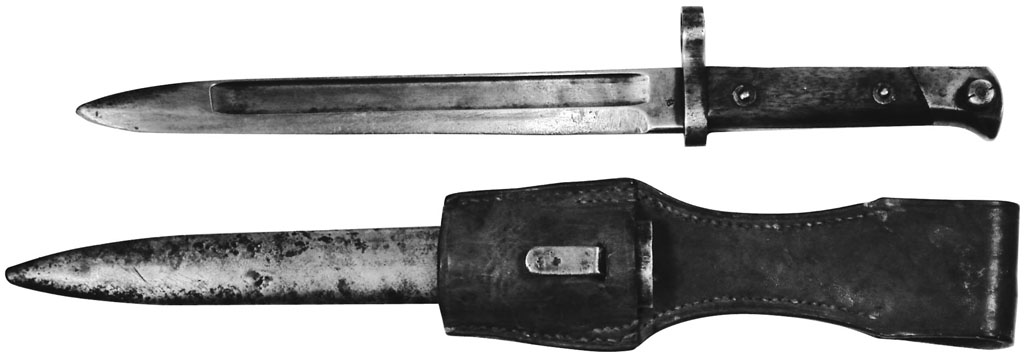
Bayonet for Steyr Model 1886 or Model 1888
Built by Steyr & Fegyvergyar
Model 1885
This was the first magazine rifle used by Austria-Hungary and the first straight-pull rifle used as a general issue shoulder arm. This model required that a clip be used to load the box magazine, loose cartridges could not be loaded. Like the U.S. M1 Garand, clips were ejected up from the receiver when empty. Chambered for the 11.15mmx58R black powder cartridge. Barrel length is 31" with two barrel bands. Box magazine held 5 clip loaded rounds. Weight was about 10 lbs. Only about 1500 of these rifles were built.
Exc. |
V.G. |
Good |
Fair |
1250 |
950 |
750 |
300 |
Model 1886
This rifle was produced in large numbers and adopted for general service use. This model is similar to the Model 1885 but unlike the M85, the clip of this rifle ejected out of the bottom of the magazine. Still chambered for the 11.15mmx58R black powder cartridge. Barrel length was 30 inches. After 1888 most of these rifles were converted to 8×50R smokeless powder. Two barrel bands with pistol grip stock. This rifle was made at Steyr. Weight was slightly under 10 lbs. Price for M 1886 in 11.15mm.58R. Many of the 1886 Steyr rifles found in the U.S. were imported from Chile and are in fair to good condition.
Exc. |
V.G. |
Good |
Fair |
750 |
600 |
375 |
200 |
Bayonet for Steyr Model 1886 or 1888
Wood grips. Muzzle ring. 9.6-inch single edge blade with the cutting edge down. Steel scabbard. These are basically the same bayonet with the muzzle opening being larger for the M1886. Price range 125 – 75.
Model 1888
This model is the same as the Model 1886 except chambered for the 8×50R black powder cartridge.
Exc. |
V.G. |
Good |
Fair |
700 |
500 |
350 |
200 |
Model 1888/1890
This variation is the result of the change-over from black powder to smokeless. This model was chambered for the 8×50R smokeless powder cartridge with a stronger bolt locking wedge. Barrel length was 30 inches. New sights were added to accommodate the new cartridge. These sights were graduated. This model was also made at Steyr. A number of these were sold to Bulgaria, Greece, and Chile. A number of these rifles were used during WWI and some were found in irregular units during WWII.
Exc. |
V.G. |
Good |
Fair |
750 |
600 |
400 |
175 |
Model 1890 Carbine
This model represented a departure from previous models, not only in design, but incorporated a stronger action to better handle the 8×50R smokeless cartridge. On this model the bolt head contained the extractor. The result of this new design was that the trigger was behind the end of the bolt handle. Barrel length was 19.5 inches with a single barrel band and no handguard. There is no bayonet lug on this rifle. The box magazine capacity was 5 rounds of clip-loaded ammunition. Weight is about 7 lbs.


Model 1888/1890 • Courtesy West Point Museum, Paul Goodwin photo

Austrian soldiers with Model 95 rifles • Courtesy Paul S. Scarlata from Mannlicher Military Rifles, Andrew Mobray Publishers
Exc. |
V.G. |
Good |
Fair |
750 |
625 |
350 |
200 |
Model 1895 Infantry Rifle
Chambered for the 8×50R cartridge, this straight pull bolt action rifle was fitted with a 30" barrel with an integral clip loaded magazine and wooden handguard. This model has essentially the same action as the Model 1890 Carbine. Fitted with leaf sights. Weight is about 8 lbs. Produced from 1895 to about 1918 both at Steyr and Budapest. The rifle was marked with either of these two locations on top of the receiver ring along with “M95.”
This was the primary shoulder arm of the Austro-Hungarian army during WWI and was made in huge quantities. The rifle was also used by Bulgaria and Greece. Many of these models were used in Italy during WWII, as well as the Balkans during that same period of time.
NOTE: In the 1930s, both Austria and Hungary converted large numbers of these rifles to 8×56Rmm. Many of these rifles were converted to carbines at the same time. Converted rifles will have an “S” or “H” stamped over the chamber. Many of the Model 1895 rifles and carbines imported recently have been re-finished. Use the very good column for the re-finished guns.
Steyr M1895 Rifle original configuration in 8×50Rmm.
Exc. |
V.G. |
Good |
Fair |
550 |
400 |
275 |
175 |
Steyr M1895 Rifle converted to 8×56Rmm
Exc. |
V.G. |
Good |
Fair |
350 |
275 |
200 |
150 |
Model 1895 Sharpshooter’s Rifle
Same configuration as the Infantry rifle except for the addition of double set triggers. Rare.
Exc. |
V.G. |
Good |
Fair |
1500 |
850 |
600 |
350 |
Model 1895 Sniper Rifle
Same as the Sharpshooter’s rifle but fitted with a telescope sight. Extremely rare. Deduct 50 percent if there is no scope.
Exc. |
V.G. |
Good |
Fair |
5000 |
4000 |
3000 |
N/A |
Model 1895 Cavalry Carbine
Essentially the same as the Infantry rifle with a shorter barrel. Barrel length is 19.5 inches. The sling swivels are located on the side on the stock and there is no bayonet lug or stacking hook. Weight is about 7 lbs. Produced until 1918.
1895 Carbine in the original 8×50Rmm.
Exc. |
V.G. |
Good |
Fair |
500 |
350 |
250 |
150 |
Model 1895 Short Rifle (Stuzen M95)
This model was designed for non-cavalry use as it was fitted with a bayonet lug and sling swivels on the underside of the rifle. It was also fitted with a stacking hook attached to the barrel band. When the bayonet is attached, a blade sight is integral with the bayonet barrel ring for sighting purposes. Weight is about 7.5 lbs.

Close-up of receiver ring of Model 1895 Steyr Rifle

Model 1895 Steyr Cavalry Carbine • Courtesy West Point Museum, Paul Goodwin photo
1895 Short Rifle in the original 8×50Rmm
Exc. |
V.G. |
Good |
Fair |
400 |
275 |
200 |
150 |
1895 Short Rifle converted to 8×56Rmm and re-finished.
Many were imported in the last few years, resulting in a stale market.
Exc. |
V.G. |
Good |
Fair |
200 |
150 |
100 |
N/A |
Bayonets for Steyr 1895 Series
Wood grips. 9.8-inch blade, cutting edge is to the top. Muzzle ring. Carbine model has a front sight blade on top of barrel ring. Made with or without a hook quillon. Crosspiece has two rivets. Ricasso can be marked “OEWG” or “FGGY” with an Austrian eagle. Refinished examples have been imported with the reworked rifles. They have electropenciled numbers. Price range 100 – 40.
Ersatz Bayonets for Steyr 1895 Series
During WWI, Austria copied the German practice of making substitute bayonets for their 1895 rifles and carbines. The two shown are examples only. Other types exist. Metal handle. Muzzle ring. 10" single edge blade. Steel scabbard. Twisted handle with riveted muzzle ring. Blade length 9.75" Steel scabbard. Price range 175 – 75.
Osterreichische Waffenfabrik Gesellschaft GmbH,
Steyr (1869-1919)
Steyr-Werke AG (1919-1934)
Steyr-Daimler-Puch, Steyr (1934-1990)
Steyr-Mannlicher GmbH, Steyr (1990-)

Bayonets for the Steyr 1895 Series


Ersatz bayonets for the Steyr 1895 Series

Bayonet for Werndl Rifles and Carbines

Werndl Model 1867/77 Rifle • Private collection, Paul Goodwin photo

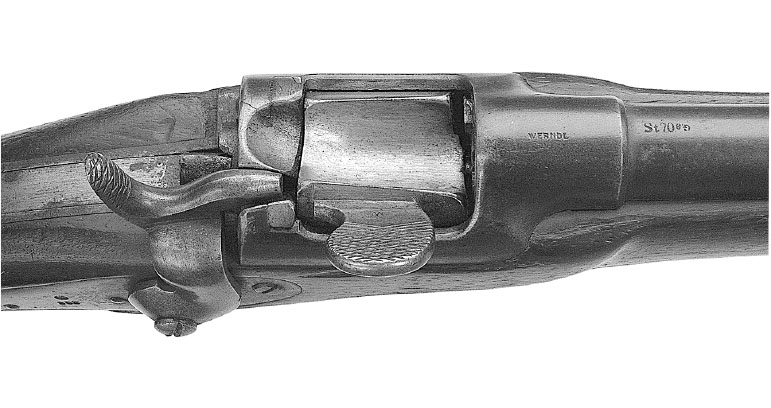
Model 95 Rifle (Model 31)
A number of Model 95 rifles and short rifles were modified to accept the 8×56Rmm cartridge after World War I. The letter “H” is stamped on the barrel or the receiver. This is a straight pull rifle with 19.6-inch barrel and a 5-round fixed magazine. Weight is approximately 7.5 lbs.
Exc. |
V.G. |
Good |
Fair |
400 |
300 |
200 |
150 |
Mannlicher Schonauer Model 1903
Built for Greece in 6.5×54mm. This rifle uses the unique rotary magazine. Some were imported in the pre 1968 era but the action for this model was popular for building custom rifles. Many Greek military were destroyed to get the actions.

Courtesy Paul S. Scarlata from Mannlicher Military Rifles, Andrew Mobray Publishers
Exc. |
V.G. |
Good |
Fair |
650 |
500 |
350 |
200 |
NOTE: For Carbine version add a 50 percent premium.
Model 1904
Similar to the Dutch Model 1895 but chambered for 8×57mm rimless cartridge. Many of these rifles were sold to China and about 11,000 were sold to the Irish Ulster Volunteer Force.
Exc. |
V.G. |
Good |
Fair |
600 |
350 |
275 |
175 |
NOTE: For Irish Ulster marked versions add a 30 percent premium.
Model SSG-PI
This model features a black synthetic stock originally designed as a military sniper rifle. Fitted with a cocking indicator, single or double set trigger, 5-round rotary magazine or 10-round magazine. Receiver is milled to NATO specifications for Steyr ring mounts. Barrel length is 26 inches. Rifle weighs about 9 lbs. Offered in 7.62 NATO.

NOTE: This model was originally called the SSG 69.
Exc. |
V.G. |
Good |
Fair |
2500 |
1800 |
1500 |
N/A |
Steyr AUG (Armee Universal Gewehr)
Produced by Steyr-Mannlicher beginning in 1978, this rifle is chambered for the 5.56×45mm cartridge. It is a bullpup design with a number of different configurations. Barrel lengths are 13.6 inches in submachine gun configuration, 16.3 inches in carbine, 19.8 inches in rifle, and 24.2 inches in a heavy barrel sniper configuration. Magazine is 30 or 42 rounds. Carry handle is an optic sight of 1.5 power. Adopted by Austrian army and still in production. Weight is 7.7 lbs. in rifle configuration. Rate of fire is about 650 rounds per minute.
Pre-1986 full-auto conversions of semi-automatic version
Exc. |
V.G. |
Good |
15000 |
12500 |
10000 |
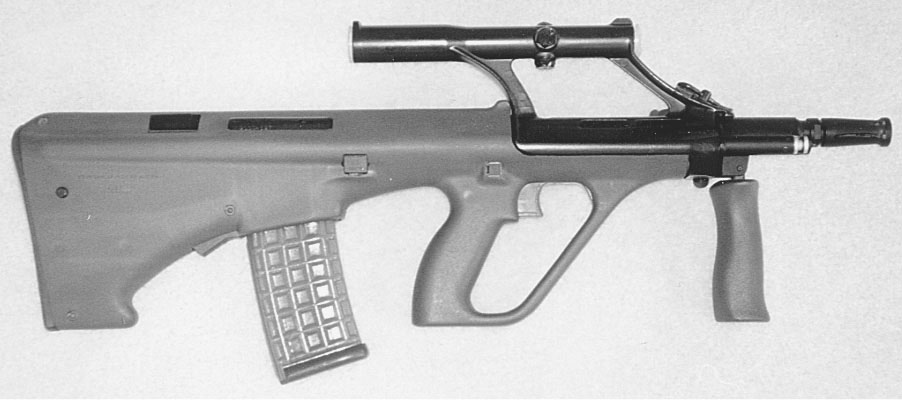
Steyr AUG • Courtesy Private NFA collection
Steyr AUG (Semi-automatic Version)
As above but in semi-automatic only. Two models, the first with green furniture and fitted with a 20-inch barrel. The second with black furniture and fitted with a 16" barrel.
First Model
Exc. |
V.G. |
Good |
Fair |
4000 |
3000 |
N/A |
N/A |
Second Model
Exc. |
V.G. |
Good |
Fair |
3500 |
3000 |
N/A |
N/A |
M1914 Rifle
This rifle is identical to the Model 1912. Austrian rifles are fitted with large sling swivels in order to accommodate the Austrian sling. Some of these rifles are unit marked on the buttplate or buttplate tang.
Exc. |
V.G. |
Good |
Fair |
800 |
600 |
450 |
200 |
Austria-Hungary also used the Maxim, having purchased some in 1889. These guns were designated the Model 89/1, then with modifications called the M89/04. Austrian Hungary used their own design, the Skoda M1893, but this gun was never considered successful.
Model 07/12 Schwarzlose
The gun was designed by Andreas Wilhelm Schwarzlose and built in Austria by Steyr. First model was the 1905 chambered for the standard military 8×50Rmm cartridge. Successor was the Model 1907/12 which was marked as the M07/12. The gun was built until 1918 in 8×50R. The Czechs built a version called the M7/24 chambered for the 7.92 cartridge. The Romanians converted Steyr M07/12s to 7.92 with lengthened water jackets. The gun was also manufactured by the Dutch, Swedish, and Hungarians. It was adopted by Austria-Hungary in 1905. It was also sold to the Dutch, Greeks, and Germans as well. It saw use in WWI. Barrel length was 24.4 inches and rate of fire was about 500 rounds per minute. Fed by a 250-round cloth belt. The gun was produced until 1918. Marked “MG SCHWARZLOSE M7/12” on the rear of the receiver. Weight is about 44 lbs. Italy used this gun, as part of World War I reparations, through World War II.
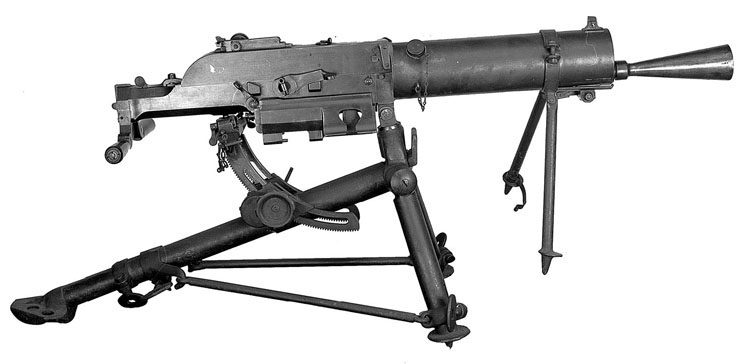
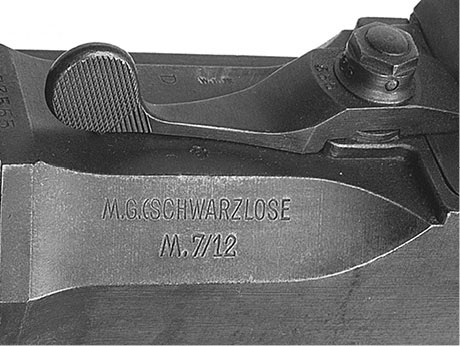
Model 07/12 Schwarzlose • Private NFA collection, Paul Goodwin photo
Aircraft versions with modified internals to increase the rate of fire were marked M7/12 (16/A) and M7/12 (16/R), and these have no jackets on the barrel. Note that the gun marked “MG SCHWARZLOSE M7/12,” which is correct, but the other side is marked “WAFFENFABRIK STEYR” with the date of manufacture underneath.
No factory Schwarzloses were built with ventilated shrouds. They were either fitted with water-jackets or had bare exposed barrels for aircraft use. No doubt there were field expedients of various sorts, but there is no evidence of any factory ventilated shrouds.
NOTE: The predecessor to this gun was the Model 1905. Its rate of fire was about 350 rounds per minute, and it was fitted with a smaller oil reservoir. An aircraft version of the Model 07/12 was the Model 07/16, which had a rate of fire of about 600 rounds per minute. Early versions were water-cooled, later versions were air-cooled. Last version had no jacket.
Pre-1968
Exc. |
V.G. |
Fair |
30000 |
27500 |
25000 |
Pre-1986 conversions (reweld)
Exc. |
V.G. |
Fair |
22000 |
20000 |
18000 |

An unusual machine gun placement; a Schwarlose in a tree • Courtesy Paul S. Scarlata